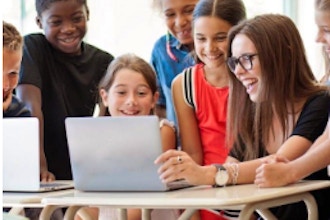The Python Programming curriculum is a one-semester course covering topics typically found in introductory computer programming (coding) courses. Other introductory programming courses are not required; students merely need to have typical computer usage skills prior to starting this course.
TEACHING STRATEGIES
The course material is designed to appeal to a variety of students, from traditional learners who thrive on written text to audio-visual students who enjoy a multi-media format. All content is delivered through an online system that allows students to work seamlessly both in the classroom and at home.
The main chapters concentrate on Python programming and computer science topics. Certain states may require additional topics ranging from computing ethics and security to career exploration to the impact of computers on modern society. The course contains additional supplemental chapters at the end that can optionally be used to meet common state requirements. Teachers may choose to assign Supplemental Lessons as desired to meet state standards or student interest.
The final “Creative Project” is optional and can be completed in small groups
COURSE PLANNER
Some classes may move faster or slower than the suggested pace.
The planner assumes students are working daily with approximately 45 to 60 minutes of class time. In most cases, the planner estimates one day per lesson (including the lesson quiz), one day per graded chapter activity (lab), and one day per chapter test. Some larger labs are assigned more time.
READING AND OBJECTIVES
Chapter One: Fundamentals of Python
- Introduction to Python
- Running Python Programs
- Writing Python Code
Chapter Two: Working with Data
- Data Types and Variables
- Using Numeric Variables
- Using String Variables
Chapter Three: Input and Output
- Printing with Parameters
- Getting Input from a User
- String Formatting
Chapter Four: Making Decisions
- Logical Expressions
- The “if” Statement
- Logical Operators
- More Complex Expressions
Chapter Five: Finding and Fixing Problems- Types of Errors
- Troubleshooting Tools
- Using the Python Debugger
Chapter Six: Lists and Loops- Lists and Tuples
- List Functions
- “For” Loops
- “While” Loops
Chapter Seven: Numeric and Data
- Dates and Times
- Advanced Data and Time Management
- Random Numbers
- The Math Library
Chapter Eight: Working with Strings
- Character Data
- String Functions
- Input Validation with “try / except”
Chapter Nine: Functions
- Writing and Calling Functions
- Function Inputs and Outputs
- Local and Global Scope
Chapter Ten: Python Classes
- Thinking about Objects
- Class Variables and Methods
- Managing Class Files
Chapter Eleven: Class Instances
• Creating Objects with Instance Data
• Instance Methods
• Managing Objects
Chapter Twelve: Food Fight Project
Chapter Thirteen: Creative Project Requirements (Scale as desired to meet available time) Design- Project Life-cycles and teams Coding Testing
Supplemental Chapter One: Python on Your Computer- Installing Python
- Managing Projects
- Using the Python IDE
Supplemental Chapter Two: Computers and Individual exercises per lesson Modern Society- Global Computing Issues
- Managing Your Digital Identity
- Impact of Computing
- Artificial Intelligence
Note: "This course outline is a general guideline, we go by the pace of the group, when it comes to coding and creativity students have to get the hang of it. We try to cover everything as much as possible.
LOCATION
ONLINE – Students will be having fun learning movie making with scratch at the comfort of their home. Zoom link will be provided
Optional: Adults can stay or take a breather.
This course is available for "remote" learning and will be available to anyone with access to an internet device with a microphone (this includes most models of computers, tablets). Classes will take place with a "Live" instructor at the date/times listed below.
Upon registration, the instructor will send along additional information about how to log-on and participate in the class.



 CourseHorse Gift Card
CourseHorse Gift Card











